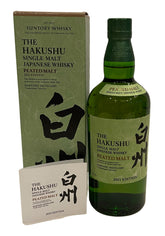The Rise of Gin: Craftsmanship, Collectibles, and Luxury Bottles

Gin’s evolution is a tale of transformation, adapting from its medicinal origins to becoming one of the most versatile and sought-after spirits globally. Over centuries, gin has experienced highs and lows, from its creation as Jenever in the Netherlands, to the chaotic Gin Craze in 18th-century England, to today’s booming craft gin movement. Now, premium gins are redefining the spirit’s place in the world, with collectors clamoring for limited-edition bottles that offer craftsmanship, rarity, and exclusivity.
Gin’s Beginnings: Jenever and Medicine
Gin traces its origins to the 16th century, when the Dutch developed Jenever, a grain spirit flavored with juniper berries. Jenever was created as a medicinal tonic and was prescribed for ailments such as digestive problems. English soldiers returning from battle during the Thirty Years' War brought the spirit to England, where it quickly gained popularity and eventually evolved into gin.
The Gin Craze and Its Aftermath
By the early 18th century, gin had become England’s most popular drink, particularly among the poor. The government’s decision to relax distillation regulations led to an era known as the Gin Craze, during which gin was produced in vast quantities. This period was marked by widespread social problems, including crime and drunkenness, as low-quality gin became more accessible than ever. The infamous engraving “Gin Lane” by William Hogarth highlighted the negative effects of excessive gin consumption during this time.
In response, the British government introduced the Gin Acts, a series of regulations aimed at improving the quality of gin and curbing its consumption. These laws helped transform gin from a cheap, dangerous drink into a more refined and respected spirit.
London Dry Gin and the Golden Age of Cocktails
The introduction of London Dry Gin in the 19th century marked a turning point for the spirit. London Dry Gin is a more refined version of earlier gins, characterized by its clean, juniper-forward profile and lack of added sweeteners or artificial flavors after distillation. This style became the preferred choice for gin drinkers and formed the backbone of many classic cocktails, such as the Gin & Tonic and the Martini.
The popularity of gin-based cocktails further cemented the spirit’s place in society, especially among the upper classes and in fashionable bars around the world.
The Craft Gin Renaissance
In the early 2000s, gin experienced a revival, thanks to the burgeoning craft spirits movement. Small-batch distillers began experimenting with botanicals and innovative distillation techniques, creating gins with distinctive and diverse flavor profiles. The resurgence of interest in gin also gave rise to specialized gin bars and festivals, where drinkers could explore new and unique expressions of the spirit.
This craft gin boom ushered in a new era of creativity and exploration, with distillers from around the world producing gins infused with exotic botanicals, such as lavender, cardamom, and citrus.
The Rise of Luxury and Collectible Gins
Alongside the craft gin movement, luxury gins have gained prominence, with collectors seeking out rare, limited-edition bottles that offer unparalleled craftsmanship and exclusivity. Some of the most expensive gins ever sold reflect this trend, including the Kyoto Ki Noh Bi set, a collection that represents the pinnacle of luxury gin.
 The Kyoto Ki Noh Bi set is one of the largest single-gin collections in the world, with 30 editions released so far. Each edition is matured in rare casks, including Karuizawa, Mizunara, and Caroni, lending unique and complex flavors. The labels on the bottles are inspired by the traditional Noh Theatre, featuring Noh masks that symbolize Japanese cultural and artistic heritage. These masks, with their intricate expressions, add a deep cultural connection and visual appeal, making the set a prized possession for both gin lovers and collectors.
The Kyoto Ki Noh Bi set is one of the largest single-gin collections in the world, with 30 editions released so far. Each edition is matured in rare casks, including Karuizawa, Mizunara, and Caroni, lending unique and complex flavors. The labels on the bottles are inspired by the traditional Noh Theatre, featuring Noh masks that symbolize Japanese cultural and artistic heritage. These masks, with their intricate expressions, add a deep cultural connection and visual appeal, making the set a prized possession for both gin lovers and collectors.
The Most Expensive Gins Ever Sold
Some gins have reached extraordinary prices at auction, showcasing the growing interest in collectible bottles. These ultra-premium gins often feature rare ingredients, intricate production methods, and beautiful presentation, making them highly desirable.
-
 Kyoto Cask Aged Dry Gin Ghost Series #13 – Currently holding the record for the most expensive gin ever sold at auction, (WhiskyAuctioneer.com in 2021) this bottle fetched £10,500. It is part of the legendary Ghost Series, curated by Stefan Van Eycken, featuring artwork inspired by Yoshitoshi's 36 Ghost Forms. Only 24 bottles were ever produced, and I quote "this bottling consist entirely of cask aged gin, being a vatting of Ki No Bi aged in 2 ex-Karuizawa sherry butts and a virgin mizunara puncheon with a subtle wisp of smoke provided by a mysterious 4th cask from farther afield."
Kyoto Cask Aged Dry Gin Ghost Series #13 – Currently holding the record for the most expensive gin ever sold at auction, (WhiskyAuctioneer.com in 2021) this bottle fetched £10,500. It is part of the legendary Ghost Series, curated by Stefan Van Eycken, featuring artwork inspired by Yoshitoshi's 36 Ghost Forms. Only 24 bottles were ever produced, and I quote "this bottling consist entirely of cask aged gin, being a vatting of Ki No Bi aged in 2 ex-Karuizawa sherry butts and a virgin mizunara puncheon with a subtle wisp of smoke provided by a mysterious 4th cask from farther afield." - Morus LXIV Gin – Another ultra-luxurious gin, Morus LXIV sold for around £4,000. This gin is distilled using hand-picked mulberry leaves and aged slowly in small batches. It comes in a handcrafted decanter with a sterling silver stopper, emphasizing the high level of craftsmanship behind it.
-
Watenshi Gin – Priced at around £2,000, this gin is distilled in minute quantities, capturing only a tiny amount of liquid from each batch. Often referred to as the “Angel’s Share” gin, Watenshi is renowned for its complexity and scarcity.
-
Nolet’s Reserve Gin – Created by the Nolet family, who have been producing spirits for over 300 years, Nolet’s Reserve is infused with saffron and verbena. The gin is bottled in hand-numbered decanters and is sold for around £700, making it a symbol of luxury and tradition.
- Anty Gin – This unique gin, made in collaboration with the Nordic Food Lab, uses red wood ants as a botanical ingredient. Priced at ~£300 per bottle, Anty Gin is an example of the experimentation that characterizes the modern gin scene.
Conclusion
Gin has come a long way from its origins as a medicinal tonic to its status today as a luxury collectible. The evolution of gin reflects centuries of innovation, with each era contributing new techniques, flavors, and styles. The rise of luxury gins, such as the Kyoto Ki Noh Bi set and the Kyoto Cask Aged Dry Gin Ghost Series #13, demonstrates how far the spirit has come in terms of quality and craftsmanship. As distillers continue to push the boundaries of what gin can be, there is no doubt that gin will remain a beloved and versatile spirit, appealing to casual drinkers and collectors alike.




